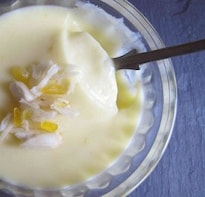The dairy
The cream used for modern possets tends to be of the kind substantial enough to stand a spoon up in. I find two exceptions to this. The first comes from Dorothy Hartley's historical collection, Food in England, and is preceded by a quote from John Dryden on the medicinal qualities of posset. (As the first poet laureate, Dryden received some of his wages in sack, so perhaps he was a bit of an expert on the preparation of the posset.) Although no source is given, the recipe seems to be an old one, as it involves boiling up milk until it froths, then curdling it with "a gill of white wine". The curds are strained and seasoned to make something a little like a sweet, mild cottage cheese: not unpleasant, but bizarre to modern tastes.Advertisement
The lemon
Where Porters and Hartley use wine, the other recipes use lemon juice to sour the mixture - which, according to my sources, is no less traditional. Having tasted a number, I decide I prefer the milder citrus flavour of Gary Rhodes' and Marcus Wareing's possets to the intense sweet and sour character of Claire Clark's version - she uses four lemons to 500ml of cream, while Rhodes uses only three to 900ml. Lovely as it is, Clark's posset is like eating lemon curd with a spoon - the mild sweetness of the cream is completely lost. Wareing also uses lemon zest in his posset, which gives it a quite different, more rounded citrus character that I really like.The sugar
Rhodes and Wareing boil the cream and sugar together, while Clark makes a syrup of lemon juice and sugar and adds it to the hot cream. This seems to give her posset a silkier texture - though I stir the other two diligently, they both have a slight graininess.The flavourings
Tamasin Day-Lewis suggests using vanilla sugar, rather than caster. Given my crusade to stop the indiscriminate use of that spice, this is a clear no. Far more interesting, in my opinion, are the nutmeg and ginger suggested by Hartley, in a nod to the dish's medieval origins. I'm not going to add much, as these are spices that have a tendency to dominate, but, as with Wareing's lemon zest, when deployed with discretion they subtly enhance the entire dish. Wareing makes a spiced fruit compote to accompany his posset, which seems too much of a distraction, but I do like Clark's toasted flaked almonds and candied peel topping, which also supplies a pleasingly medieval feel.Advertisement
Tips of the trade
Clark and Wareing both sieve their possets, which, though I'm sceptical, does seem to make a difference to the final texture. Clark also advises going over the top of the dish with a blowtorch to eliminate any bubbles before chilling. This does work, if you're averse to bubbles - without a Michelin star to maintain, I'm not too bothered.The perfect lemon posset
Makes 3-42 lemons
125g caster sugar
425ml double cream
Pinch of nutmeg
Pinch of ginger
1 tbsp flaked almonds, toasted
1 tbsp candied peelFinely grate the zest of one of the lemons, then juice 1½ - you should have about 100ml juice, but juice the remaining half if necessary.Put the juice and zest in a small pan with the sugar over a low heat and bring to the boil, stirring occasionally, until the sugar has dissolved. Keep warm.
Advertisement
Sweet, silky, citrussy: perfect posset. Photographs: Felicity Cloake for the Guardian
Advertisement
For the latest food news, health tips and recipes, like us on Facebook or follow us on Twitter and YouTube.
Advertisement
